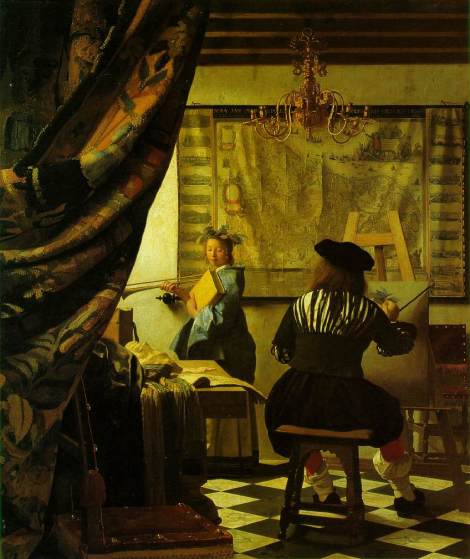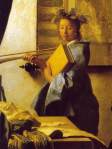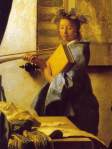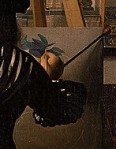
This painting is called The Art of Painting, but it is also known as The Allegory of Painting or Painter in his studio. It is a famous 17th century oil on canvas painted by Jan Vermeer, a known Dutch painter. Many experts in art believe that this work is an allegory of painting, and thus, the different titles.
Johannes Vermeer was a Dutch Baroque painter who was specialized in painting domestic interior scenes of ordinary life. In his life he produced relatively few paintings (35 paintings), and thus left his family in debt at the time of his death. He painted few paintings as he worked slowly and with great care. Bright colours were common in his paintings, but sometimes he also used expensive pigments. However, he is renowned for his use of light. Although for a time his paintings were forgotten, he was rediscovered by Gustav Friedrich Waagen, and since then, his reputation has grown, being now acknowledged as one of the greatest painters of the Dutch Golden Age.
Not much of his life is known, just that he seemed to have been devoted to his art in the city of Delft (of which there is a painting by him), that he was married (his wife is usually said to be the subject in most of his paintings) and that he had many children.
After this brief introduction of the painter, I am going to focus on the painting above, The Art of Painting. It is one of the 35 paintings attributed to Vermeer, painted around 1666, and its dimensions are 130cm x 110 cm. It is nowadays displayed in the Museum of Vienna.
The Art of Painting has all the characteristics of Vermeer’s artistic genius, but, moreover, it stands apart from his other works, as it is the largest and more complex of all of them. In the painting we see a seventeenth-century Dutch interior illuminated by diffused light and exquisitely painted details. It is indeed believed that this painting was really important to Vermeer, because it remained in his possession until his death. Even when the family was left in financial straits, it was not sold.
The painting has only who characters: the painter and his subject, a woman, and the title presents an artist depicting her dressed as Cleo, the muse of history. The painter is painting her in his studio, by a window and with the background of a large map, and the studio in which this everyday scene is taking place is filled with objects: a map, a tapestry, and a chandelier, among others. He is dressed in an elegant costume (black jacket, red hose, white boot hose and black slippers) and is looking carefully to his model. Indeed, the painter is thought to be a self-portrait of Vermeer, but the face is not visible, so it is not known for sure. Apart from the subject and the objects of the room, it is as well important to pay attention to the impact of light streaming through the windows.
According to some experts, there are some symbolisms in The Art of Painting:
 1) The subject is the Muse of History, Clio: This is evidenced by the facts that she is wearing a laurel wreath, holding a trumpet (which depicts fame) and carrying a book (which represents history; this book is thought to be a book by Thucydides).
1) The subject is the Muse of History, Clio: This is evidenced by the facts that she is wearing a laurel wreath, holding a trumpet (which depicts fame) and carrying a book (which represents history; this book is thought to be a book by Thucydides).
Vermeer, by placing the Muse of history at the center of his allegory, emphasized the importance of history to the visual artist.
 2) The double headed eagle: This eagle is the symbol of the Austrian Habsburg dynasty and former rulers of Holland, and it adorns the central golden chandelier. According to some experts, it may represent the Catholic faith, as Vermeer and his family were Catholic in a Protestant Holland. Moreover, the absence of candles on the chandelier may as well represent the suppression of the Catholic faith.
2) The double headed eagle: This eagle is the symbol of the Austrian Habsburg dynasty and former rulers of Holland, and it adorns the central golden chandelier. According to some experts, it may represent the Catholic faith, as Vermeer and his family were Catholic in a Protestant Holland. Moreover, the absence of candles on the chandelier may as well represent the suppression of the Catholic faith.
 3) The map at the back: The map was made by Claes Jansz Visscher and it has a rip that divides the Netherlands between the north and the south. This rip symbolizes the division between the Dutch Republic to the north and the Habsburg controlled provinces to the south.
3) The map at the back: The map was made by Claes Jansz Visscher and it has a rip that divides the Netherlands between the north and the south. This rip symbolizes the division between the Dutch Republic to the north and the Habsburg controlled provinces to the south.
 4) The mask: The mask is found on the table next to the artist, and it is thought to be a death mask, representing the ineffectiveness of the Habsburg monarch (and thus connected with the map).
4) The mask: The mask is found on the table next to the artist, and it is thought to be a death mask, representing the ineffectiveness of the Habsburg monarch (and thus connected with the map).
(The mask can be seen down at the left of the picture)
The technique used in the painting is really interesting too. Vermeer did not left behind any drawing, so the information about his artistic process can only be figured out from Vermeer’s paintings. The Art of Painting is really useful in this matter, as it depicts a painter painting his muse:
 Through this painting, by paying attention to the painter, we can figure out how Vermeer painted: He sat while painting rather than stood at his easel and he used his maulstick to steady his hand while painting. First, he covered the canvas with a light gray ground and indicated his composition with white lines, and later he applied strokes of colour. After that, he finished by applying different glazes and highlights.
Through this painting, by paying attention to the painter, we can figure out how Vermeer painted: He sat while painting rather than stood at his easel and he used his maulstick to steady his hand while painting. First, he covered the canvas with a light gray ground and indicated his composition with white lines, and later he applied strokes of colour. After that, he finished by applying different glazes and highlights.
(This technique is used in The Art of Painting, but examinations have shown that he often followed the same procedure in the majority of his other paintings).
He was a master using light, as explained above, and in this painting, just as in the others, light plays an important part: in The Art of Painting Vermeer gave more attention to light and textural effects at the rear of the room. Moreover, the light falling across Clio’s hands, face and robe show the softness of Clio’s skin. The effect of light is also visible on the map, where the light models its form and reflects its aged appearance. Finally, another object captured by the light is the chandelier, where the sunlight reflecting off its polished surface makes it really beautiful. This light contracts in an amazing way with the dark parts of the chandelier.
As a summary, I am going to point out the most important points of the article: This painting is a famous 17th century oil on canvas painted by Jan Vermeer, a Dutch Baroque painter who was specialized in painting domestic interiors scenes of ordinary life. This painting was really important for him, as it remained in his possession until his death, even when the family went through financial straits. He worked slowly and with great care, bright colours were common in his paintings and although for a time his paintings were forgotten, he was rediscovered and since then, his reputation has grown, being now acknowledge as one of the greatest painters of the Dutch Golden Age.
The Art of Painting was painted around 1666 and has all the characteristics of Vermeer’s artistic genius. In the painting we see a seventeenth-century Dutch interior illuminated by diffused light exquisitely painted details and it has only who characters: the painter and his subject, a woman, and the title presents an artist depicting her dressed as Cleo, the muse of history. In the painting we find many objects, such as a map, a tapestry, and a chandelier. The main symbolisms in the painting are: the Muse of History (the model), the double headed eagle, the map at he back and the mask. Through the painting, we can also see the technique he used: First, he covered the canvas with a light gray ground and indicated his composition with white lines, and later he applied strokes of colour. After that, he finished by applying different glazes and highlights. He was a master using light and in this painting, just as in the others, this plays an important part.
Have you taken large parts of this from Wikipedia without quoting it?
Pingback: Pravah-01 « Know Thyself!·
i had read somewhere, that the painting was a studio work to show potential customers how competent and clever he was. thats why he hung on to it.